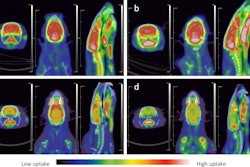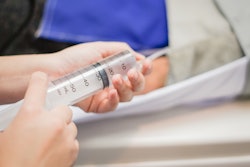
Using a multiuse syringeless injector (MUSI) for CT contrast exams reduces medical waste compared to using single-use syringe-based injectors (SUSI), a study published June 26 in Academic Radiology has found.
The findings are hopeful for supporting efforts to make radiology more "green," as well as streamlining the imaging process, according to a team led by Giuseppe Toia, MD, of the University of Wisconsin in Madison.
"Switching from SUSI to MUSI ... may fortify institutional endeavors toward green radiology initiatives," the team wrote. "The potential time saved administering contrast using MUSI may improve CT technologist efficiency.
Physicians and healthcare administrators are becoming increasingly aware of the need to make patient care environmentally sustainable, the authors noted. Some specialties, such as anesthesia and surgery, have engaged in sustainability research, but radiology efforts have lagged. ("Green" initiatives decrease energy consumption, generate less waste, recycle materials, and use biodegradable material.)
"[Radiology] efforts are only beginning to change," the group wrote. "There are many opportunities for radiology sustainability best practices."
One area to address in this regard is contrast-enhanced CT exams. Contrast is packaged in single-use plastic vials of varying sizes and injected into patients with a syringe-based power injector. But syringeless power injectors -- 500 mL plastic containers of contrast -- eliminate the need to reload iodinated contrast media and plastic consumable pistons between exams. (Contrast is injected via tubing attached to the contrast container and a syringe.)
Toia and colleagues investigated potential time and material waste (of contrast, plastic, saline) saved using a multiuse syringeless injector rather than a single-use syringe-based injectors. The study was conducted over three workdays, and 15 CT technologists were surveyed on their experience with SUSI and MUSI via a five-point scale. The researchers collected contrast, plastic, and saline waste information from 1,444 patients and used a mathematical model to estimate total and categorical waste from each type of injection system over a 16-week period.
The team found that, on average, CT technologists spent 40.5 seconds less per exam when they used multiuse syringeless injectors compared to single-use syringe-based injectors (p < 0.001); they rated the work efficiency, user-friendliness, and overall satisfaction higher with multiuse syringeless injectors compared to single-use syringe-based injectors (p < 0.05).
| Comparison of waste production between two types of CT contrast injectors | ||
| Type of waste | SUSI | MUSI |
| Iodine waste | 31.3 liters | 0 liters |
| Plastic waste | 467.7 kg | 71.9 kg |
| Saline waste | 43.3 liters | 52.5 liters |
| Total waste | 550 kg | 124.4 kg |
"Switching from SUSI to MUSI resulted in a 100%, 84.6%, and 77.6% reduction in ICM, plastic, and total waste," Toia's group reported.
A relatively simple protocol switch can have far-reaching effects, the authors concluded.
"[Our study suggests] that MUSI aligns with green radiology best practice initiatives in reducing overall departmental waste ... [and] may offer time savings benefits allowing CT technologists to focus on other clinical tasks."
The complete study can be found here.





















